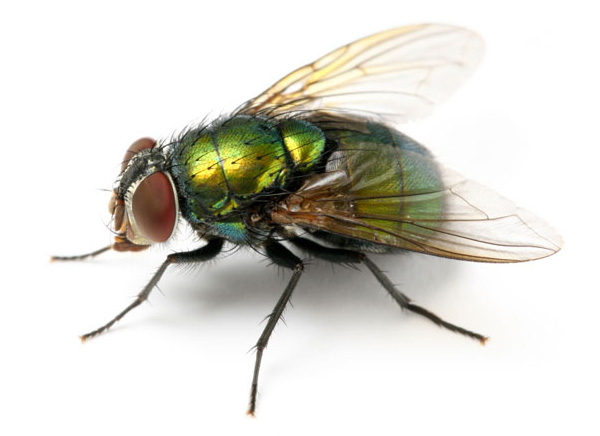Flies 101

They buzz, they swarm, and they can turn lunch at a sidewalk café into a swatting match. The ubiquitous, annoying fly isn’t an insect we usually worry about, but it can prove more of a health hazard than you’d think. Scientists have identified almost 100,000 different species of flies worldwide, from the tiny fruit fly to the large horse fly, causing humans and pets alike a host of problems.
About Flies
True flies are part of the order Diptera (from the Greek di, meaning “two,” and ptera, “wings”). Some types have long proboscises designed to stab into a human or animal, and anyone who’s been bitten by a horse fly won’t be surprised to learn that some species have scissors-like mandibles. The fly’s penchant for garbage, dung, carrion, and other bacteria-laden environments make them not only unwelcome in our lives but bona fide health hazards. Many species are known to transmit worms, protozoans, and a variety of other pathogens. The mosquito, infamous carrier of malaria, yellow fever, and other diseases, is actually a type of fly and probably the one whose presence is most irritatingly felt.
Even the common house fly can pose a health threat to your dog if he becomes a victim of fly strike. Biting flies attack a dog’s ears or face because he is less able to defend these areas. Flies may also be attracted to earwax, a cut or wound, or the scent of an infection. The dog will scratch at the fly bites, aggravating the irritation and perhaps drawing blood, which only attracts more flies. If he’s allergic to the fly bites, a more serious reaction could ensue. Damaged skin makes a suitable fly breeding ground, and the next thing you know, your dog may become infested with maggots.
We may have to share the planet with flies, but there’s no reason why we have to share our living spaces with them. These simple steps can make your indoor and outdoor environments less attractive to these nasty pests, which will help keep you and your dog healthy and happy.
Outdoors
- Pick up dog waste in the yard.
- Tightly cover garbage cans and move them away from living areas.
- Enclose compost piles and remove any decaying matter from the yard.
- Pick up soiled food dishes (yours and your dogs) when dining al fresco, and clean up any food scraps in the area.
- Change outdoor water bowl contents frequently. Stagnant water is a breeding habitat for many fly species.
Indoors
- Use screens on open doors and windows to keep flies out.
- Cover any exposed food items, including dog food and treats.
- Clear away soiled food dishes (yours and your dogs) at mealtime’s end, picking up any spilled food that was missed.
- Securely tie off full garbage bags and move them away from the house.
- Kill flies indoors by spraying directly with Bio Spot Active Care™ Flea & Tick Home Spray.